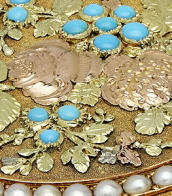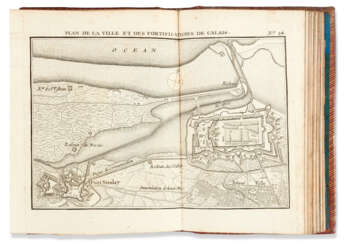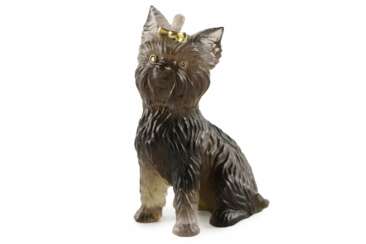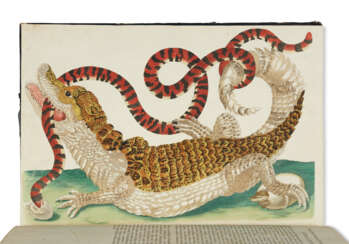cadre miniature




Charles Le Bastier, son of a Paris mercer of the same name, was apprenticed on 3 October 1738 at the age of 14, to Gabriel Vougny, marchand-orfèvre-joaillier. With the sponsorship of Jean Moynat, himself a noted gold box maker, Le Bastier became master goldsmith on 20 December 1754. He worked from the same premises in the rue Thévenot, near the rue St-Denis, until last recorded in 1783. Le Bastier was a successful and prolific maker of gold boxes who also supplied other retailers such as Jean-François Garand and Grancher of Du Petit Dunkerque, whose name or shop name appear engraved on the rims of several of Le Bastier's boxes. In the special tax list of 1774, he was listed 9th in order of the importance of his business. Since a number of Le Bastier's boxes survive in various collections (most notably in the Louvre and the Thurn und Taxis Museum, Regensburg), it is possible to trace the progression of his work from the earliest silver boxes with coloured gold ornament through a series of richly chased but comparatively plain gold boxes to the almost immediately recognisable gold and enamel boxes of his maturity.


Adrien Vachette was a French jeweler of the 18th and 19th centuries, best known as the creator of the so-called Wonderful Medallion.
Vachette was one of the most famous and prolific craftsmen of his generation. He was appointed court jeweler and supplier to the court of King Louis XVIII. Gold, tortoise shell, enamel, precious stones and ornamental stones were used extensively in the creations of Vachette, particularly in the many precious snuffboxes that were in fashion at the time.
However, he became famous at a very advanced age, when he was almost 80 years old. Paris at the time was experiencing a cholera epidemic and a period of political instability. The Archbishop of Paris, Iasent-Louis de Quelan, had the idea of solving these problems by a miracle. At his behest, Vachette designed a "miraculous medallion" depicting Our Lady. Between 1832 and 1836, more than two million copies were distributed. At the same time, Archbishop Kaelan and his clergy were active in the fight against cholera. All in all, this contributed to the growth of religiosity and respect for the church in France, and the marvelous medallions of Vachette's design continue to be minted and distributed in many Western countries to this day.




Maria Sibylla Merian was a German-born naturalist and artist renowned for her contributions to entomology and botanical art. Born in Frankfurt am Main in 1647, Merian gained recognition for her detailed studies and illustrations of insects and plants, focusing on their life cycles and metamorphosis, which significantly advanced the field of entomology.
Maria Sibylla Merian's journey into the world of natural history began in her hometown of Frankfurt, where she started studying insects, particularly their metamorphosis. Her marriage to Johann Andreas Graff, an artist's apprentice, eventually took her to Nuremberg, where she continued her work and published her findings. Despite personal challenges, including an unhappy marriage, Merian's dedication to her studies remained unwavering.
A pivotal moment in Merian's life was her association with the Labadist community, where she delved deeper into her studies. Her time with the Labadists in Friesland allowed her to study a variety of species, further enriching her scientific endeavors. Merian's relentless pursuit of knowledge eventually led her to Amsterdam, a hub of scientific inquiry and trade, where she was exposed to a vast array of specimens from across the globe.
Maria Sibylla Merian's most ambitious expedition was to Suriname in South America, where she studied and documented the region's diverse flora and fauna. Her observations and illustrations from this expedition were groundbreaking, providing valuable insights into the natural world. Merian's works, including her detailed engravings and illustrations, not only captivate with their beauty but also serve as valuable scientific records. Her legacy is preserved in institutions like the National Museum of Women in the Arts, which houses some of her remarkable engravings.
Maria Sibylla Merian's life and work exemplify the profound impact of combining art and science, leaving an indelible mark on both fields. Her dedication to observing and documenting the natural world continues to inspire scientists and artists alike.
























![Peintre miniaturiste au monogramme I. G [Ivan Gavrilovitch GRIGORIEV ?]. Circa 1820](/assets/image/picture_45401/fc04b/6hbpmdksgtnaj2zfqjmu3gi5eq2s-ix1oxzz2lholtxc1volsdhnk2flbkwjtl1509641145jpg__fix_374_244.jpeg)
![Peintre miniaturiste au monogramme I. G [Ivan Gavrilovitch GRIGORIEV ?]. Circa 1820](https://veryimportantlot.com/assets/image/picture_45401/fc04b/6hbpmdksgtnaj2zfqjmu3gi5eq2s-ix1oxzz2lholtxc1volsdhnk2flbkwjtl1509641145jpg__fix_374_244.jpeg)


















![[NEPVEU, Auguste, éditeur (1775-1837)] et Jean-Baptiste Joseph BRETON, dit DE LA MARTINIÈRE (1777-1852)](/assets/image/picture_2501139/5c61f/fff3200bb7bb8f88ba81840986c4ed531667984400jpg__fix_374_244.jpeg)
![[NEPVEU, Auguste, éditeur (1775-1837)] et Jean-Baptiste Joseph BRETON, dit DE LA MARTINIÈRE (1777-1852)](https://veryimportantlot.com/assets/image/picture_2501139/5c61f/fff3200bb7bb8f88ba81840986c4ed531667984400jpg__fix_374_244.jpeg)

![[NEPVEU, Auguste, éditeur (1775-1837)] et Jean-Baptiste Joseph BRETON, dit DE LA MARTINIÈRE (1777-1852)](/assets/image/picture_2501145/999ea/8366893c42a86340325557a0bd91913b1667984400jpg__fix_374_244.jpeg)
![[NEPVEU, Auguste, éditeur (1775-1837)] et Jean-Baptiste Joseph BRETON, dit DE LA MARTINIÈRE (1777-1852)](https://veryimportantlot.com/assets/image/picture_2501145/999ea/8366893c42a86340325557a0bd91913b1667984400jpg__fix_374_244.jpeg)





![[Heures imprimées sur vélin]](/assets/image/picture_2500861/45a67/6206d49e01ac5af20632b782f954f2ed1667984400jpg__fix_374_244.jpeg)
![[Heures imprimées sur vélin]](https://veryimportantlot.com/assets/image/picture_2500861/45a67/6206d49e01ac5af20632b782f954f2ed1667984400jpg__fix_374_244.jpeg)











